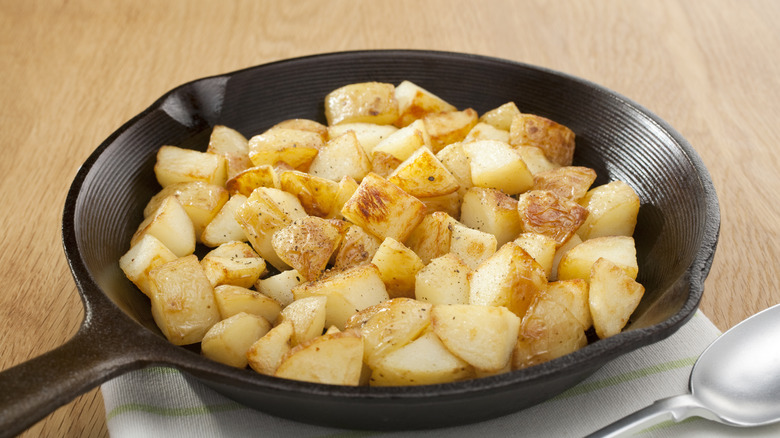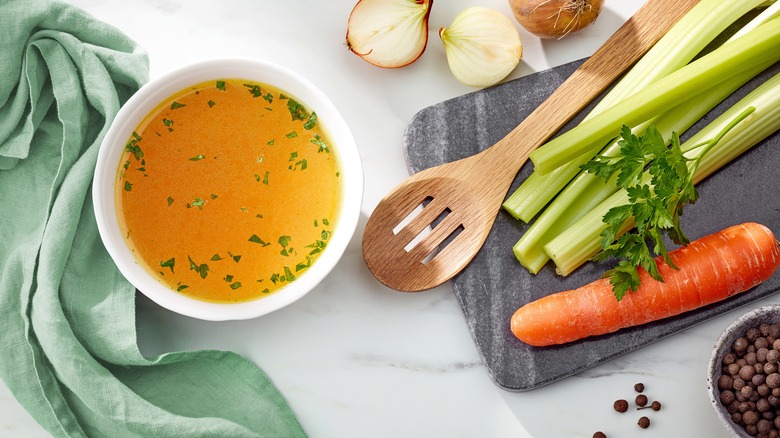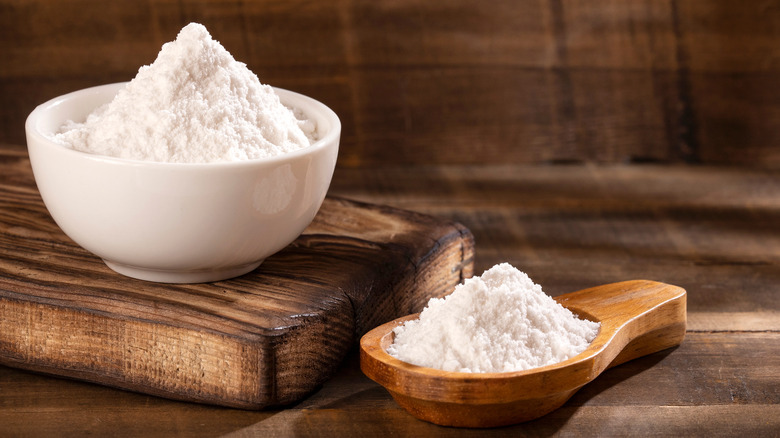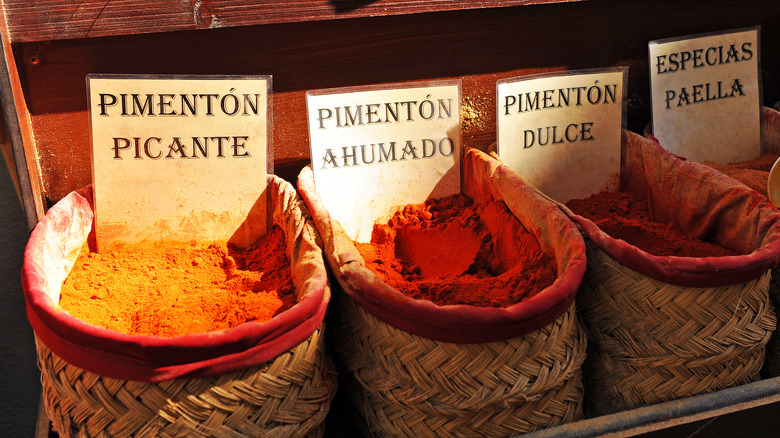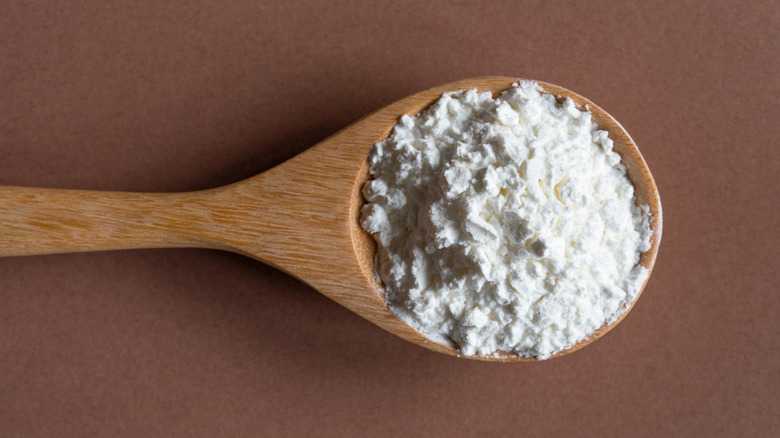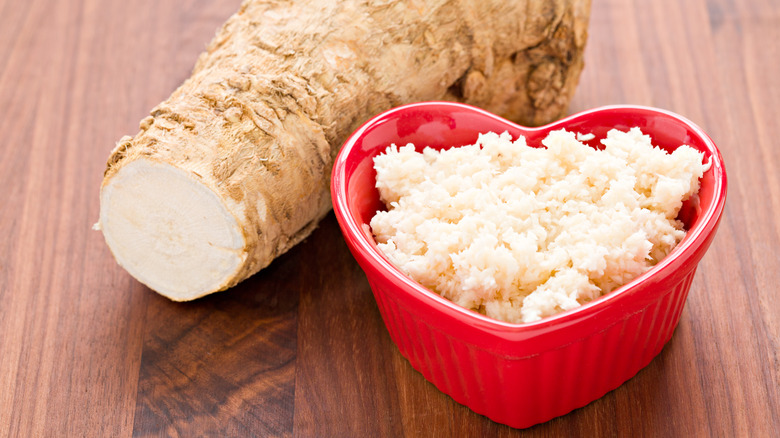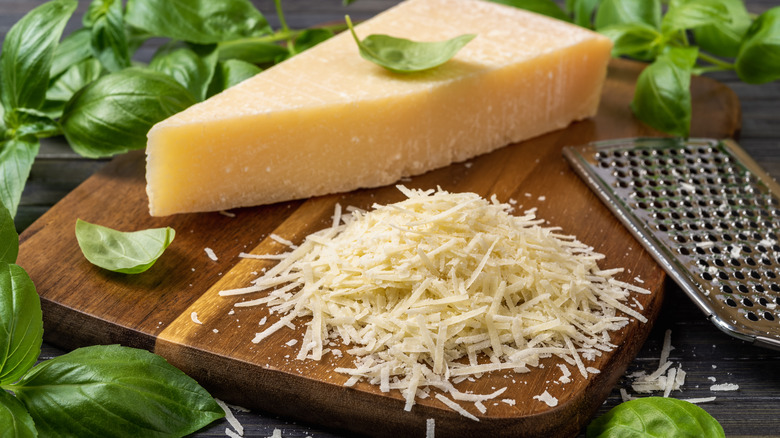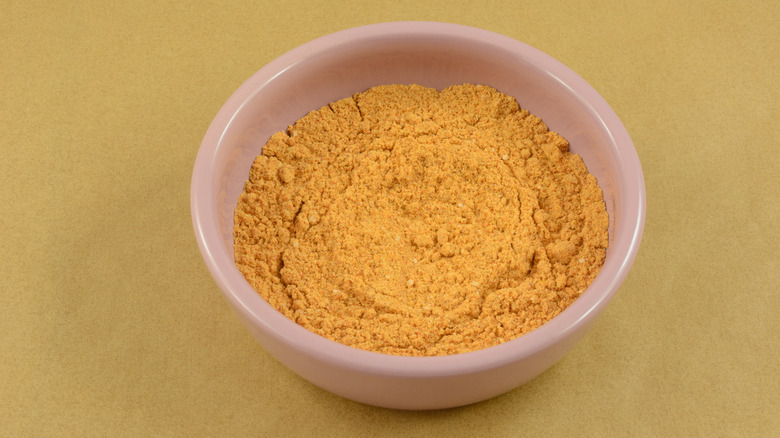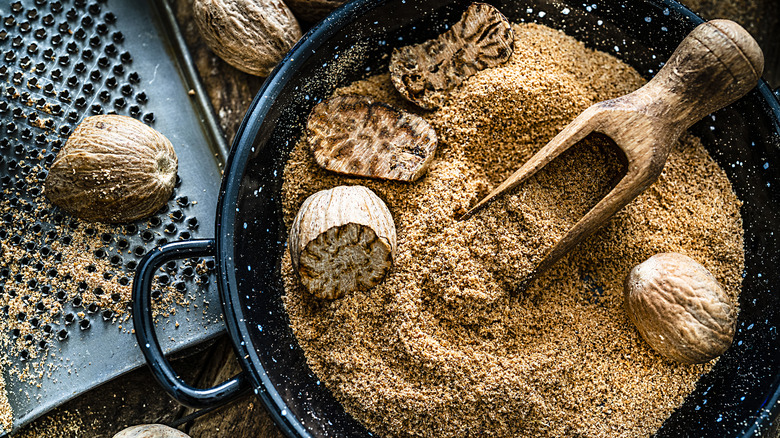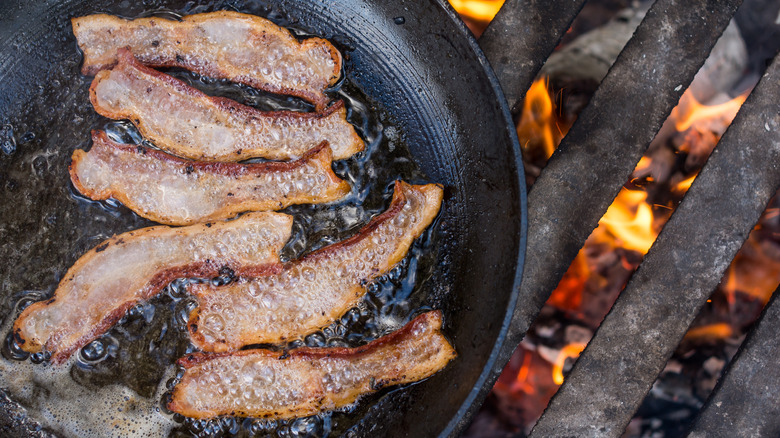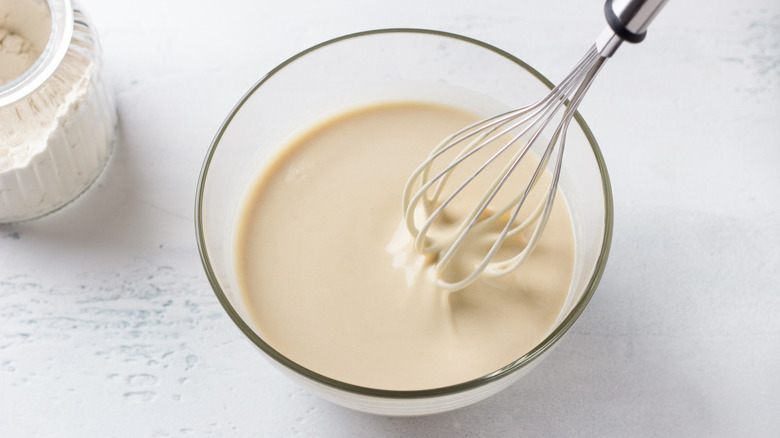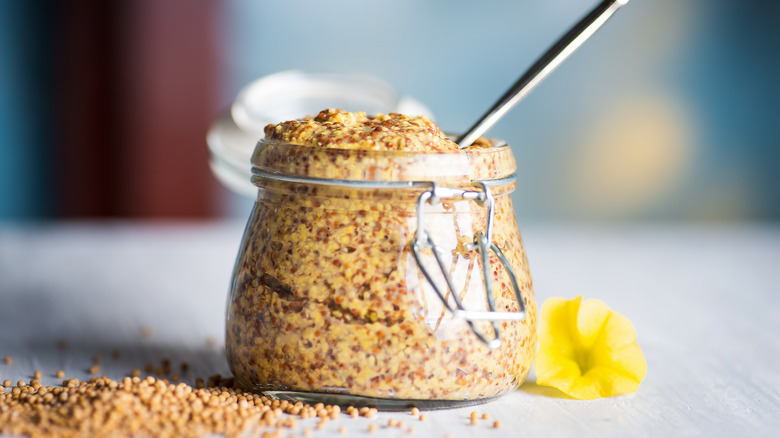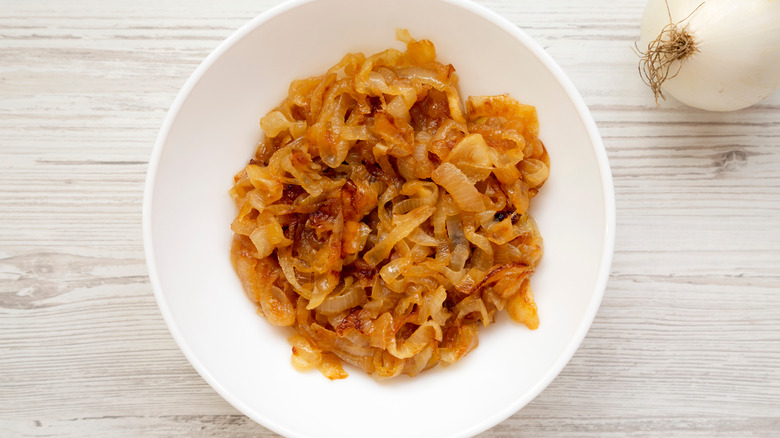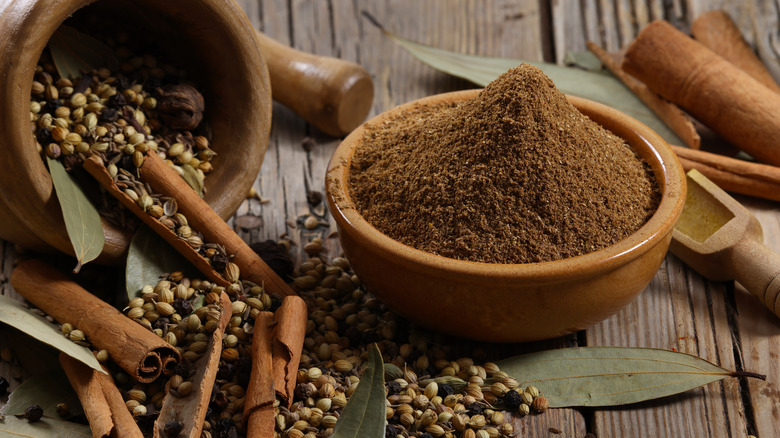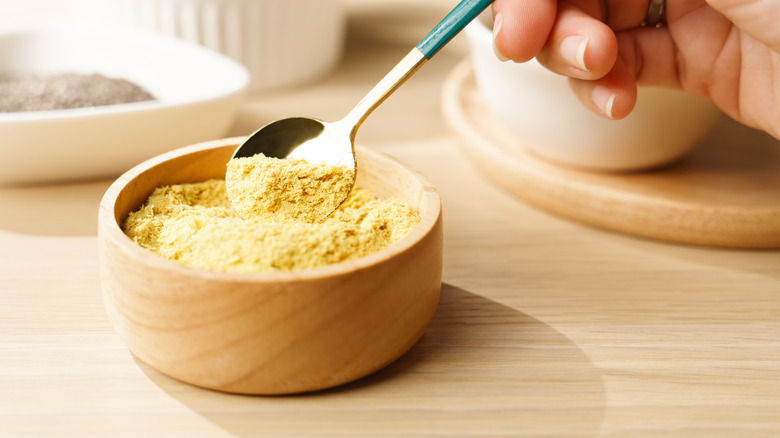14 Secret Ingredients To Make Your Breakfast Potatoes Even Better
There are few better ways to start the day than with breakfast potatoes. The ideal side to a portion of eggs and sausage, breakfast potatoes are quick and simple to make, and give your morning meal much-needed carbohydrates and fiber. The basic recipe for breakfast potatoes requires little more than some good-quality potatoes, fat, a few easy-to-find seasonings like salt and pepper, and a way to cook them. Although they are usually fried in a skillet, you can also make breakfast potatoes in your air fryer or pop them in your oven to roast them.
When cooked properly, breakfast potatoes are crispy on the outside, fluffy on the inside, and totally moreish. But they can also have a knack for ending up pretty plain. While their neutral, gentle taste is part of their appeal, there are loads of ways to make breakfast potatoes way more interesting. Additional ingredients can either serve to balance out the creaminess of the potatoes with spice, sweetness, or umami, or make the potatoes even crispier or lighter. The good news, too, is a lot of these secret ingredients are ones that you'll already have at home.
1. Chicken stock
One of the best secret ingredients for breakfast potatoes is one that you add very early on in the cooking process: chicken stock. To make sure the potatoes are cooked properly, it's a good idea to boil them before frying them. This not only ensures they're tender enough on the inside but also gives them a softer, rustled exterior, which makes them crunchier when fried.
And to boil them, you should be using chicken stock. Chicken stock infuses your potatoes with additional flavor as they boil, permeating right through to their very center — unlike regular water, which won't give much flavor at all. Chicken stock also provides more than just salt. It has a savory taste that supplies the potatoes with umami, as well as hints of herbs and spices that round out the flavor.
Any chicken stock will do, with even the cheapest versions made from a cube still supplying additional taste. If you don't have chicken stock or follow a plant-based diet, vegetable stock is a great alternative. It's probably best to avoid using beef stock, however, as its darker color can seep into the potatoes, making them too brown.
2. Baking soda
Some ingredients are not about improving flavor so much as texture and baking soda definitely falls into the latter camp. It is a surprising, yet effective ingredient that you add during the boiling stage of your breakfast potatoes. "Baking soda breaks down the pectin in the potato and draws starch to the surface," explains SoBou General Manager and Chef de Cuisine Byron Halliburton via Insider. This change in texture, which is enabled by the pH levels of the water altering to become more alkaline, makes the outside of the potato rougher. And the rougher the outside, the crispier they get when fried.
Importantly, you don't need much baking soda for this change to occur, nor do you need to boil them for very long. Add ½ teaspoon of baking soda into a pot of boiling water or stock and dunk your cubed potatoes in for a minute or two. You can increase their roughness even more by giving them a quick shake in a closed pot after draining them, which will ruffle their surfaces, giving you loads of crispy bits when fried. Crucially, baking soda also won't affect the flavor of your potatoes significantly, so it won't get in the way of any other seasonings.
3. Pimentón
Paprika is one of the most common spices to add to breakfast potatoes, but it's important to remember that not all paprika is the same. The spice comes in many different strengths and flavor profiles, with smoked, sweet, and hot paprikas being the most common. For the perfect paprika for your breakfast potatoes, though, we'd recommend using pimentón. This Spanish paprika is one of the key ingredients in chorizo, and it has a bold taste and a deep red color that makes your potatoes pop.
Pimentón differs from other paprikas because of its production process. For pimentón, the capsicum peppers undergo a slow drying process and are rotated gently while being smoked with oak wood from below. This gives them an ultra-rich, powerful flavor, which means you generally have to use less of it than regular paprika to get the desired effect. Pimentón is also a regular ingredient in patatas bravas and paella recipes, where it supplies depth, savoriness, and a smoky taste. I
Pimentón can vary in heat and sweetness as much as other paprikas. For the sweet version, look for "pimentón dulce." The hot version is usually found under the name "pimentón picante." To use it, sprinkle some over your potatoes while they're frying, or use it as a topping just before serving.
4. Starch
When cooked well, potatoes become totally crispy on the outside –- but getting there can be hard work. If your potatoes are carrying too much moisture or are crowded in the pan, they'll steam instead of developing a crispy coating. Too little fat, meanwhile, and they'll become charred and brittle, and may stick to your skillet.
But aside from using a large pan to cook them in and ample fat, one key way to develop crispiness is to use a starch, like cornstarch or potato starch. Adding starch to the outside of potatoes allows you to skip boiling them beforehand, which tends to make the outside more capable of browning and crisping up. Simply coat them with your chosen starch and a little water, and then fry as usual in plenty of fat.
The starch on the outside of the potatoes works in the same way that it would when coating meat or vegetables, generating a crunchy coating. As cornstarch and potato starch are basically flavorless, they won't distract from the flavor of the potato itself. Additionally, you can add any seasonings you like to the starch to give the breakfast potatoes a boost of taste.
5. Horseradish
There are plenty of ways to add spice to breakfast potatoes, but people tend to fall back on using paprika, chili powder, or hot sauce. And while these definitely provide a kick, horseradish is an underappreciated method of boosting the fire factor. Horseradish generates its spice through a chemical called allyl isothiocyanate, which is also present in mustard and wasabi. This oil tends to produce a heat that we feel in our nasal passages instead of primarily on our tongues, and as such it's a nice way to give your potatoes a different type of spice.
Horseradish also has an earthy, radish-esque flavor, which supplies your potatoes with increased depth. There are several ways that you can add it to breakfast potatoes. Horseradish sauce can be used as a dip or you can gently mix it through the potatoes to provide sharpness, tang, and heat. You can also grate fresh horseradish onto the potatoes, or add horseradish powder. Bear in mind, though, that those last two methods can produce some serious heat, and there's a very fine balance between not enough horseradish, and enough to make you uncomfortable. Start with less than you think, and work your way up.
6. Parmesan
One of the main issues with breakfast potatoes is that while they're reliable, comforting, and fluffy, they don't tend to offer much complexity in their flavor. But by using parmesan, all of that can change. Parmesan delivers a deeply savory, somewhat funky flavor to the potatoes. As a matured cheese, it has an especially high flavor concentration compared to other dairy products and is particularly abundant in glutamates, the ingredient that gives it its umami taste.
Using parmesan is also an unexpected way to get crispier breakfast potatoes. Because it has a low moisture content (thanks, again, to its maturity), it has an uncanny ability to become crispy fast when it's fried. By coating your breakfast potatoes in a dusting of parmesan, you can achieve a flavor-packed crunch fast, with the parmesan granules absorbing the fat of the pan and becoming deeply bronzed. Coating breakfast potatoes with parmesan also allows you to reduce the amount of salt you need to add to them. If you don't have parmesan lying around, any hard cheese will also work well. It's best, though, to parboil your potatoes before you use parmesan to coat them, as it will brown quite fast.
7. Taco seasoning
One of the best ways to add instant depth to breakfast potatoes is with a spice blend you might already have in your cupboard. Regular taco seasoning gives them a Tex-Mex vibe and prevents them from tasting too flat or one-note. Most taco seasonings have spices like cumin or paprika and dried herbs like oregano or thyme, all of which balance each other out and create a well-rounded flavor profile. Some taco seasonings will also have added ingredients like flour or cornstarch, which help the spices adhere to your potatoes more effectively and give them a crispier exterior.
Remember, though, that some taco seasonings may also contain surprisingly high levels of sodium or sugar. While this may make them taste better, it can also give them a nutritional impact you might not want. Luckily, you can make your own easy taco seasoning at home with spices you likely have on your spice rack.
8. Nutmeg
If we had to pick one spice that was seriously underused year-round, we'd have to choose nutmeg. This spice is common around the holidays, but its complex flavor, filled with nutty, earthy, slightly spicy, and sweet notes, adds a lot to a dish whatever the weather is. And nutmeg is especially useful when it comes to recipes that have a fairly neutral flavor base, like white sauces and breakfast potatoes. With potatoes specifically, nutmeg helps to boost their natural earthiness, and gives a hint of spice that somehow pairs with the vegetable beautifully.
It's important with nutmeg to use less than you think, as too much can make your potatoes taste bitter. If you want the full impact, grate your own nutmeg using a microplane, which will deliver more of the oils that give the spice its taste. Ground nutmeg can also work well, and may be a more convenient option. We would recommend not using nutmeg on its own, and instead thinking of it as a base to which you can add more interesting flavors, like curry spices, cheese, or hot sauce.
9. Bacon grease
When we think of adding ingredients to breakfast potatoes, we usually think of spices or herbs we can sprinkle on top. But what about the fat we use? Our choice of fat has a huge impact on the flavor of potatoes, considering that it coats every single part of the food. And while olive oil and butter give their own flavor, imparting nuttiness and creaminess respectively, bacon grease is our preferred choice. Frying your breakfast potatoes in bacon grease fills them with the savory, salty flavor of bacon, which never overpowers the potatoes. It also keeps the taste within the flavor profile of your plate (which, we hope, includes bacon too).
The best part is that you can use the bacon grease from the bacon you've cooked for breakfast. Simply pull your pieces of bacon out and pop them under a warm grill so they don't cool down. Then add your breakfast potatoes, and fry them in the leftover fat. This method saves on food wastage and stops you from having to use a different pan. Alternatively, save the bacon grease from another recipe in a jar in the fridge until you use it with your potatoes. When kept at a consistently low temperature, bacon grease will last for up to three months.
10. Pancake mix
One of the most surprising ingredients for breakfast potatoes comes from a totally different breakfast item. Dry pancake mix is a secret ingredient that provides both flavor and texture. The flour and leavening agents in the pancake mix coat the potatoes, and when it's fried, it becomes both crispy and fluffy. The flavorings, meanwhile, give the potatoes a gentle sweetness and a light saltiness that isn't overpowering and instead rounds out the overall flavor profile.
The result is a pile of breakfast potatoes that, surprisingly, doesn't taste like pancakes, but has a distinctly comforting taste. If you're using pancake mix, however, it's really important to make sure you use enough fat. You should aim for the mix to completely cover the potatoes as any coating that isn't cooked in fat will remain chalky and unpleasant to eat. Deep-frying your potatoes can help prevent this and will give you the crispiest effect possible. It's also a good idea to partially cook your potatoes before adding the pancake mix to ensure that it doesn't burn while you're trying to cook them through. Boil them for a minute or two, and allow them to completely cool before coating them so the mix doesn't get wet and gummy.
11. Mustard
Mustard and potatoes are a natural fit, but when it comes to breakfast potatoes, it's an often-neglected condiment. We're here to change that. Mustard gives a spicy, salty, tangy flavor to breakfast potatoes that is often missing from the plate in other forms, and makes your overall meal more interesting. Sweet mustard gives less of a nose-itching heat and instead gives potatoes a briny nuance. Hot mustard, meanwhile, brings the fire and makes the potatoes bolder.
You can add mustard in many different forms, from a sprinkling of mustard powder on the potatoes (which can give intense heat) to squirting it on the side as a dip. But one of the best ways to use it is to prepare your potatoes in mustard-flecked oil, which also gives you a hands-off and stress-free cooking experience. Mix whole-grain mustard with olive oil and toss your cubed potatoes in it before transferring the mixture onto a baking sheet and roasting them until cooked. Make sure you flip them over halfway through so they brown evenly on each side.
12. Caramelized onions
Adding extra vegetables to breakfast potatoes can be hit-or-miss. While throwing in chunks of peppers or celery can add extra textures and further bulk up the dish, they can also crowd the pan and may not add much by way of flavor. You also run the risk of the dish turning into a breakfast hash, instead of serving breakfast potatoes.
One vegetable, though, gets our seal of approval: the humble caramelized onion. Pre-caramelized onions are ideal to add to breakfast potatoes as they bring maximum flavor and an entirely new texture in small amounts, boosting the potato while ensuring that it remains the star of the show. Caramelized onions provide a deep, caramel-like sweetness, combined with the savory notes of the vegetable, which interplay excellently with the saltiness of the potato. Their softness works well with the crispiness of the vegetable, offering a counterpoint and combining with the potatoes' pillowy interiors.
It's best to always caramelize your onions separately and mix them into the potatoes once they've finished cooking, instead of trying to cook both in the same pan. Caramelizing onions requires a low-and-slow cooking process, and trying to cook your potatoes like this will break them down way too much. You can also buy jarred caramelized onions and spoon them over the potatoes just before serving.
13. Garam masala
While curry flavors and potatoes go hand-in-hand, it can be a trickier thing to get right at breakfast. The intense flavor of some curry powders can be too much first thing in the morning, and when combined with breakfast potatoes, may become the dominant element on your plate. Garam masala, however, is the ideal way to add curry spices in a subtle, fragrant way. Garam masala (which literally means "warming spice mix") is a blend that is composed of aromatic spices like cinnamon, cloves, cumin, coriander, and cardamom. While garam masala can be hot, it tends to provide gentle, yet dynamic complexity to a dish.
You can make your own garam masala blend at home if you have the spices on hand, but premade versions may be an easier option. Some garam masalas are also roasted, giving the spices an extra depth and a toasted edge, which works well with the potatoes. The spice should be added towards the end of your cooking process to prevent the flavor subtleties from being lost while the potatoes are frying. It can also be used as a garnish, sprinkled over the potatoes just before you serve.
14. Nutritional yeast
Nutritional yeast is on the radar of many people who follow plant-based diets, as a source of plant-based protein that also has a high nutritional value. But the main reason plant-based eaters and meat-eaters alike should be using it, especially for their potatoes, is because of its flavor. Nutritional yeast has an intense cheesy flavor that's often compared to parmesan, and a saltiness that seasons breakfast potatoes with maximum efficiency. When used as a coating, it can also become crispy and brittle, making it the perfect option to give your potatoes extra crunch.
To use nutritional yeast, dust parboiled potatoes in a few tablespoons of it and then fry them in oil. It has a tendency to become a little dry without enough moisture, so using enough oil is essential. You can also employ nutritional yeast by scattering it over the potatoes when they're already on the plate. To round out the flavor even more, mix some garlic powder with the nutritional yeast before coating your potatoes with it.
